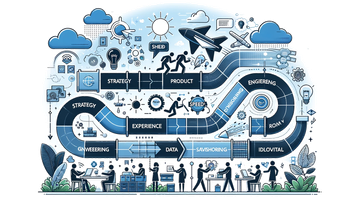Crafting an Effective Experience Pipeline - Insights and Strategies

Introduction #
In today's digital landscape, creating a seamless and impactful user experience is paramount. An experience pipeline serves as the backbone for this, integrating design, development, and deployment processes cohesively. This blog post draws insights from various expert sources, including Samrawit Yoseph's detailed exploration of leveraging design systems for multi-tenant growth, to outline the essential workflow and considerations for an effective experience pipeline.
Understanding the Experience Pipeline #
An experience pipeline is a structured approach that ensures consistent, high-quality user experiences across all digital platforms. It emphasizes the integration of design systems, like the WATTS system discussed by Yoseph, to streamline design and development processes.
Key Components of the Pipeline #
- Design Systems: Central to the pipeline, a design system ensures consistency and scalability. It includes reusable components and guidelines that save time and enhance user experiences.
- Collaboration and Communication: Cross-functional teams must work closely, sharing insights and feedback to refine the user experience continually.
- Agile Methodology: Adopting agile practices allows for flexibility and rapid iteration, essential for responding to user needs and market changes.
Considerations for Building Your Pipeline #
- User-Centric Approach: Always prioritize the end-user's experience and needs during the pipeline development.
- Scalability: Ensure the pipeline supports growth, allowing easy integration of new features or platforms.
- Performance Optimization: Regularly assess and enhance the performance to meet users' expectations for speed and reliability.
- Accessibility: Make inclusivity a core aspect of your pipeline to reach a broader audience.
Workflow Essentials for an Experience Pipeline #
- Foundation: Start with a deep analysis of existing design and code outputs to establish a solid foundation.
- Standards: Emphasize accessibility and user experience by adhering to principles that ensure content is perceivable, operable, understandable, and robust.
- Design Tokens: Utilize design tokens for consistency in applying basic design system rules, streamlining the handover from design to development.
- Tools Integration: Leverage tools like InVision DSM, Sketch, React, and Storybook to facilitate design and development processes.
Team Collaboration Across Crafts #
The success of an experience pipeline hinges on seamless collaboration between designers and developers. Establish a common language and source of truth for UI assets and code to ensure consistency. Encourage open communication, regular feedback, and shared responsibility for the project's success.
Challenges and Solutions #
Implementing an experience pipeline is not without its challenges. Balancing brand identity with consistency, ensuring efficient collaboration among diverse teams, and maintaining a focus on performance and accessibility are common hurdles. Solutions include clear communication, robust design systems, and ongoing testing and feedback loops.
Prioritizing SPEED in Digital Transformation #
Publicis Sapient's SPEED philosophy emphasizes Strategy, Product, Experience, Engineering, and Data to navigate digital business transformation successfully. This approach is not just about moving fast but ensuring that every step taken is aligned with strategic goals, driven by user experience, and supported by robust engineering and insightful data analysis. SPEED enables organizations to quickly adapt to market changes, innovate continuously, and stay ahead of competition by making informed, agile decisions. It underscores the importance of moving swiftly but thoughtfully, ensuring that every product launched and experience crafted delivers real value to users and sustains business growth.
Conclusion #
Developing an effective experience pipeline requires careful planning, collaboration, and a commitment to user experience excellence. By considering the insights and strategies outlined, organizations can build a pipeline that supports dynamic growth and meets the high expectations of today's digital users.